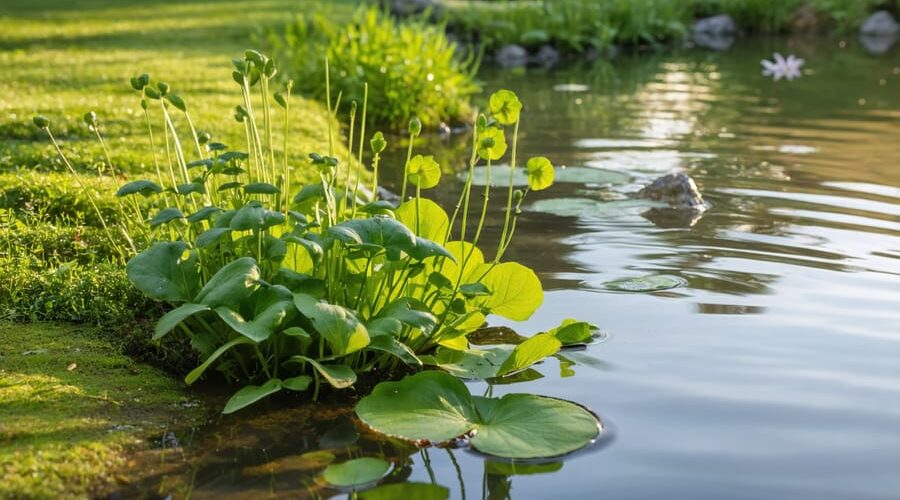
These Edible Bog Plants Will Transform Your Pond Into a Productive Oasis
Your pond can produce fresh, edible harvests while looking beautiful and supporting a healthy ecosystem. Bog plants thrive in the shallow, waterlogged margins of water features where conventional vegetables struggle, turning otherwise decorative spaces into productive growing zones. Many water gardeners don’t realize they’re already creating perfect conditions for crops like watercress, water celery, and arrowhead tubers just by maintaining their pond edges.
The key is choosing plants that serve multiple purposes. Edible bog varieties filter water naturally, provide habitat for beneficial insects and amphibians, and give you fresh ingredients for your kitchen without sacrificing the aesthetic appeal you’ve worked to create. Unlike terrestrial gardens that demand constant attention to watering and soil amendments, these aquatic edibles largely care for themselves once established in the nutrient-rich, consistently moist environment your pond naturally provides.
Starting small makes sense. Add one or two edible species to your existing setup this season, observe how they interact with your fish and filtration system, and expand from there. Most edible bog plants are vigorous growers that adapt easily to various water depths and light conditions, making them forgiving choices even if you’re new to combining food production with ornamental water gardening. The result is a pond that feeds both your household and your passion for creative, sustainable landscaping.
Why Edible Bog Plants Belong in Your Pond
If you’re already enjoying a pond in your backyard, why not make it work even harder for you? Edible bog plants transform your water feature from purely decorative into a genuine food source while actually improving your pond’s health. I discovered this myself when I planted watercress along my pond edge years ago—not only did it taste amazing in salads, but the water seemed clearer too!
These remarkable plants that thrive in water offer multiple benefits that make them worth considering. First, they provide natural filtration by absorbing excess nutrients like nitrogen and phosphorus that would otherwise fuel algae blooms. Their root systems act as living filters, pulling impurities from the water and leaving it cleaner for your fish and other aquatic life.
Speaking of fish, edible bog plants create perfect fish and flora harmony. The plants provide shade that keeps water temperatures stable, offer hiding spots for fish to feel secure, and even produce oxygen during daylight hours. Meanwhile, your fish contribute nutrients that help the plants grow more vigorously—it’s nature’s perfect cycle.
Beyond the practical benefits, these plants attract wonderful wildlife to your pond. Dragonflies, butterflies, and beneficial insects will visit regularly, while birds may stop by for a drink. You’ll create a thriving ecosystem right in your backyard.
The aesthetic appeal shouldn’t be overlooked either. Many edible bog plants are genuinely beautiful, with interesting foliage, delicate flowers, or architectural forms that enhance your pond’s visual appeal. And there’s something deeply satisfying about stepping outside to harvest fresh greens or roots from your own water garden. You’re not just maintaining a pond anymore—you’re cultivating a sustainable food source that looks gorgeous and supports a healthy aquatic environment. It’s the ultimate multitasking garden feature.
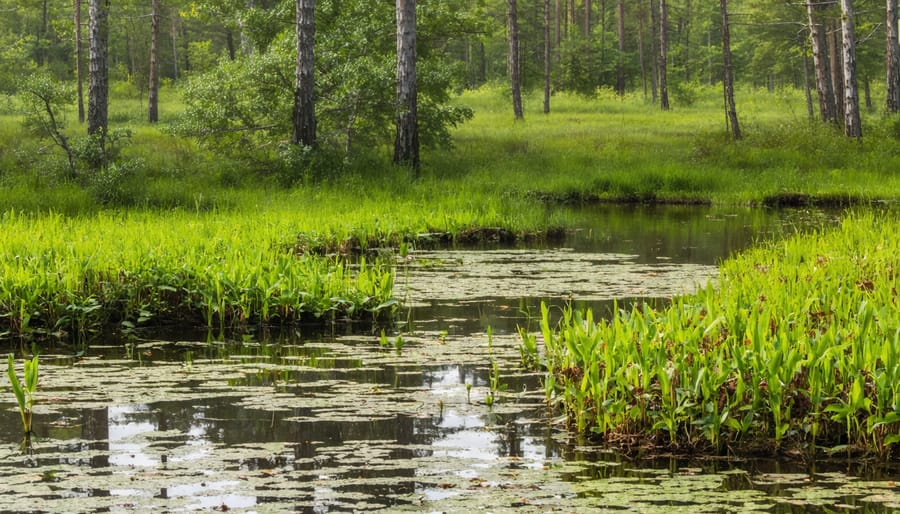
Understanding Bog Conditions in Your Pond
Natural Bog Zones vs. Created Bog Areas
When you’re thinking about growing edible bog plants, you’ll quickly discover there are two main approaches: working with what nature provides or rolling up your sleeves to create something new.
Natural bog zones are those wonderful shallow edges around existing ponds where the soil stays consistently moist but isn’t permanently underwater. If you already have a pond, take a walk around its perimeter and look for those squishy spots where water naturally seeps into the surrounding soil. These areas are perfect for many edible bog plants and require almost no modification. I’ve found some of my most productive watercress patches growing in exactly these naturally soggy edges.
But what if your pond has steep sides or doesn’t have these natural transition zones? That’s where created bog areas come in, and they’re easier to make than you might think!
Here’s a simple approach to create your own bog garden: Choose a spot adjacent to your pond where you can dig a shallow depression about 12 to 18 inches deep. Line it with pond liner, then poke several small drainage holes to prevent complete stagnation. Fill the depression with a mixture of sand, peat moss, and garden soil in equal parts. This creates that perfect moisture-retentive environment that bog plants adore. You can even connect it to your pond with a small channel or position it to catch pond overflow during heavy rains.
The beauty of created bog areas is complete control over size, location, and growing conditions while still benefiting from your pond’s ecosystem.
Water Depth and Soil Requirements
Getting the water depth and soil just right is honestly the secret to success with edible bog plants! Most bog-loving edibles thrive in shallow water, typically anywhere from saturated soil to about 2-6 inches of standing water. I learned this the hard way when I first planted cranberries in water that was way too deep – they sulked for months until I moved them to the bog shelf!
The ideal soil mixture mimics what you’d find in natural wetlands. Think acidic and organic-rich. I create my bog soil by mixing equal parts peat moss (or coconut coir if you prefer a sustainable option), coarse sand, and composted pine bark. This combination holds moisture beautifully while still allowing some drainage, which prevents that stagnant, smelly situation nobody wants.
For plants like watercress and water celery that prefer flowing conditions, position them where your pond’s circulation keeps things moving gently. Meanwhile, cranberries and wild rice appreciate more stable water levels. The beauty of bog gardening is that you can create different zones around your pond to accommodate various plants’ preferences. Just remember to skip fertilizers – bog plants evolved in nutrient-poor conditions and too much feeding can actually harm them!
Top Edible Bog Plants for Your Pond
Watercress: The Easy Starter Plant
If you’re new to edible bog plants, watercress is your perfect starting point. I still remember the thrill of snipping my first handful just two weeks after planting – that’s how fast this beauty grows! Watercress thrives in shallow water or consistently soggy soil along pond edges, making it incredibly forgiving for beginners.
To get started, simply anchor watercress stems or plants in 2-4 inches of slow-moving water where they’ll receive partial shade to full sun. The plants will root quickly and spread across the water surface, creating a lush green mat. You can harvest continuously by cutting the top 4-6 inches of stems, which encourages even bushier growth. The best part? Fresh watercress delivers that distinctive peppery bite that transforms ordinary salads into restaurant-worthy dishes.
One heads-up from my own experience: watercress can be enthusiastic about spreading, so keep an eye on it if you have a smaller pond. Regular harvesting naturally controls its growth while keeping your kitchen stocked. Just rinse your harvest thoroughly before eating, and you’ll have a nutrient-packed superfood right from your backyard water garden!
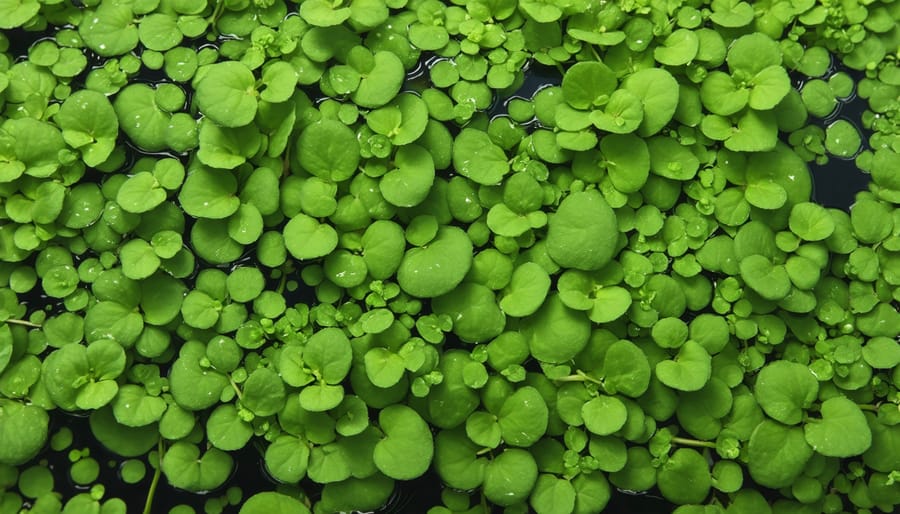
Water Celery (Oenanthe javanica): Your Asian Greens Garden
If you’re new to edible bog plants, water celery is your perfect starting point. This Asian staple has been a favorite in my pond for years because it practically grows itself. Just plant it in shallow water or saturated soil at your pond’s edge, and watch it take off. It tolerates partial shade and spreads happily without becoming invasive, making it wonderfully forgiving for beginners.
The hollow stems and bright green leaves have a mild celery-parsley flavor that transforms stir-fries, soups, and hot pots. I love tossing handfuls into ramen or using it as a garnish for dumplings. Harvest by snipping stems with scissors, leaving the base intact for continuous regrowth throughout the season. In my experience, it keeps producing from spring through fall, even surviving light frosts.
Water celery works beautifully with pond fish since they generally leave it alone while appreciating the cover it provides. Plant it in containers if you want to control its spread, or let it naturalize along muddy margins where it creates lush, productive borders. Within weeks of planting, you’ll have fresh Asian greens just steps from your kitchen, proving that water gardening can be both ornamental and delicious.
Cattails: The Survival Plant
If you’re looking for a true survival plant that gives back generously, cattails are your new best friend! These impressive bog dwellers offer not just one, but four edible parts throughout the growing season.
In early spring, harvest the young shoots when they’re about knee-high. Simply grasp firmly near the base and pull upward with a slight twist. Peel away the outer leaves to reveal the tender white core, often called “Cossack asparagus.” It’s crisp, mildly sweet, and perfect raw in salads or lightly sautéed.
Come early summer, those distinctive brown flower heads produce golden pollen that you can shake into bags for a protein-rich flour substitute. Mix it half-and-half with regular flour for pancakes with a unique, slightly sweet flavor.
The starchy roots, or rhizomes, are best harvested in fall or early spring. Wash thoroughly, peel, and boil them or dry and grind into flour. They’re quite fibrous, so patience pays off.
One heads-up from my own pond: cattails spread aggressively through underground rhizomes. Plant them in submerged containers to keep them manageable, or designate a specific bog area where they can naturalize without taking over your entire water feature.
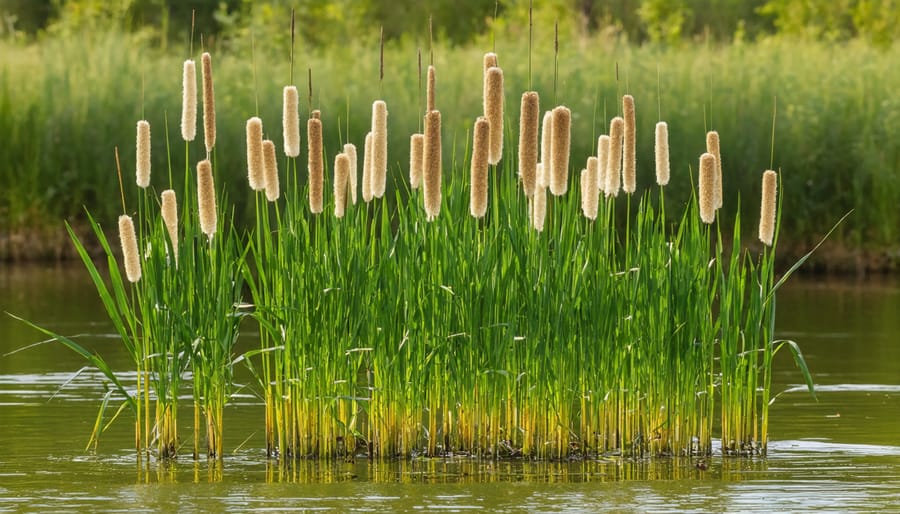
Arrowhead (Duck Potato): The Underground Harvest
Arrowhead produces potato-like tubers that Native Americans harvested for centuries, and you can enjoy this ancient tradition right from your own pond! The plants develop marble to golf ball-sized tubers at their root tips during the growing season, ready for harvest in late fall after the first frost knocks back the foliage.
Harvesting feels like a treasure hunt. You can wade into shallow water and gently feel around the muddy bottom near the plant base, or dig carefully from the shore. The tubers detach easily, so work slowly. I’ve found the best hauls come from plants grown in 4-8 inches of water with rich, mucky soil beneath. Some tubers float loose during harvest, making collection easier than you’d think!
Timing matters. Wait until October or November when the plant has stored maximum starch in those underground nuggets. The cold weather actually improves their flavor, making them sweeter and less bitter.
For cooking, peel away the thin skin and boil or roast the white flesh inside. They taste similar to potatoes with a slightly nutty sweetness. Try them mashed, added to stews, or sliced thin and fried into chips. Store unwashed tubers in cool, damp sand for winter use, just like your ancestors did.
Bog Cranberry: Sweet Rewards from Acidic Conditions
Cranberries are the superstars of edible bog plants, but they’re also the pickiest about their growing conditions. Here’s what you need to know to succeed with these delicious berries.
First, cranberries are serious about acidity. They need a pH between 4.0 and 5.5, which is more acidic than most garden plants prefer. Test your bog soil with an inexpensive pH kit from your garden center. If your pH is too high, work sulfur into the soil or use peat moss as a growing medium. I learned this the hard way after my first cranberry plants languished for a season until I finally tested my soil.
These low-growing evergreen plants need full sun and consistently moist, not waterlogged, soil. Position them at the bog’s edge where water levels stay steady but drainage is adequate. The ideal setup is a dedicated bog pocket filled with a mixture of half peat moss and half sand, which naturally maintains that acidic sweet spot.
Space plants about 12 inches apart and mulch with pine needles to help maintain acidity. Don’t expect berries the first year. Cranberries take patience, typically fruiting in their second or third season. Once established, though, you’ll enjoy harvests for decades from these hardy perennial plants.
Water Mint and Other Aquatic Herbs
Water mint is my absolute favorite aquatic herb – once you crush those leaves near your pond on a warm afternoon, you’ll understand why! This vigorous spreader thrives in shallow water or boggy margins, producing edible leaves perfect for teas, cocktails, and garnishes. The purple flowers also attract beneficial pollinators to your pond area.
Here’s the thing about water mint and similar herbs like watercress and brooklime: they can be wonderfully productive but also enthusiastically invasive. I learned this the hard way when my water mint colonized half my pond in one season! Now I always plant aquatic herbs in submerged containers. Use fabric grow bags or plastic pond baskets filled with heavy clay soil, and sink them into your bog area or shallow shelves. This containment method lets you enjoy fresh herbs without them overtaking your entire water feature.
Watercress deserves special mention as a nutritional powerhouse. It grows best in cool, flowing water but adapts well to pond edges if you refresh the water regularly. Harvest the tender top growth frequently – this actually encourages bushier plants and prevents flowering, which can make leaves bitter. Both water mint and watercress are hardy perennials that’ll return year after year, providing fresh flavor right from your backyard water garden.
Designing Your Edible Bog Garden Layout
Balancing Aesthetics and Function
Creating a stunning edible bog garden doesn’t mean sacrificing practicality! I learned this lesson early on when I planted cranberries at the back of my bog where they looked gorgeous but required wading through knee-deep water to harvest. Not my smartest move!
Start by placing your tallest plants like watercress or water celery toward the back or center, creating natural height variation. Position frequently harvested plants like mint and watercress along easily accessible edges. This way, you can snip what you need for dinner without trampling other plants or doing acrobatics over your pond.
Think about pathways too. Even simple stepping stones placed strategically give you dry-footed access to your productive plants. I’ve found that grouping the same species in clusters of three or five creates attractive focal points while making harvest simpler. You’re grabbing multiple handfuls from one spot rather than playing hopscotch around your bog.
Color coordination matters as well! Mix the deep burgundy tones of certain water celery varieties with bright green watercress for visual interest. Add flowering rush for vertical drama without blocking your harvest zones.
Remember, the best design lets you enjoy both the beauty of your bog garden and the fresh flavors it provides without needing a yoga certification to reach your crops!
Managing Growth and Preventing Overgrowth
Some edible bog plants can be enthusiastic growers, and that’s actually good news for your harvest! However, you’ll want to keep them from taking over your entire pond. Let me share some simple strategies I’ve learned over the years.
For spreading plants like watercress and mint, containment is your best friend. Plant them in submerged containers or use barriers to keep their roots from wandering. I use sturdy plastic pond baskets with fine mesh lining, which works wonderfully. You can even create dedicated “zones” in your bog area for different plants, making it easier to manage each one’s territory.
Regular harvesting is your secret weapon for controlling growth while enjoying fresh produce. With watercress and water celery, I pick the outer stems every week or two during growing season. This keeps plants bushy rather than sprawling and actually encourages more tender new growth for eating.
For plants like arrowhead that spread through runners, simply remove unwanted shoots in spring before they establish. It takes just minutes but prevents hours of work later.
Division every 2-3 years keeps plants healthy and vigorous without letting them dominate. This refreshes your healthy pond ecosystem while giving you extras to share with fellow water gardeners. Think of it as pruning your fruit trees – necessary maintenance that improves productivity.
Planting and Establishment: Step-by-Step
Getting your edible bog plants settled into their new home is easier than you might think, and timing makes all the difference. Spring through early summer is your golden window for planting, when water temperatures are warming up and plants are naturally ready to put down roots and grow vigorously.
Start by choosing the right containers. I’ve learned the hard way that regular pots just float away or tip over! Use heavy-duty aquatic planting baskets or fabric pond pots with drainage holes. Fill them with specialized aquatic planting soil or heavy clay-based garden soil, but skip regular potting mix as it floats and clouds your water.
For most edible bog plants like watercress or water celery, place them so the crown sits just at or slightly above the soil surface. Press the soil firmly around the roots to eliminate air pockets, then top with a one-inch layer of pea gravel or small river rocks. This crucial step prevents fish from uprooting your plants and keeps soil from muddying the water.
Position your planted containers at the appropriate water depth for each species. Watercress thrives in very shallow water or constantly moist soil, while water chestnuts need several inches of standing water. Create shelves or use upturned pots to achieve the perfect height if your pond doesn’t have built-in planting ledges.
During the first two weeks, check your plants daily. They might look a bit droopy initially while adjusting to their new environment, which is completely normal. Remove any yellowing leaves promptly to prevent decay in the water. If you notice plants floating up, add more rocks around the base.
Water quality matters tremendously during establishment. Avoid adding fertilizers for the first month, your pond’s existing nutrients are usually sufficient. Watch for aggressive growth from existing pond plants that might shade out your newcomers, and trim back any overenthusiastic neighbors. With patient attention during these early weeks, your edible bog plants will reward you with vigorous growth and tasty harvests for seasons to come.
Caring for Your Edible Bog Plants Through the Seasons
Your edible bog plants will reward you with delicious harvests when you give them a little attention throughout the year. Let me walk you through what I do in my own bog garden during each season.
Spring is planting time! Once the soil temperature reaches about 50°F, your plants wake up from winter dormancy. This is when I divide overcrowded cranberries and refresh the soil around my watercress. Add a thin layer of acidic compost around acid-loving plants like blueberries, and check that your water level hasn’t dropped too low after winter. If you’re adding new plants, spring gives them a full growing season to establish strong roots.
Summer means management mode. Keep an eye on water levels, especially during hot spells. I check mine twice weekly in July and August. Your plants should be growing vigorously now, so pinch back watercress to encourage bushier growth and prevent it from getting leggy. Watch for yellowing leaves, which often signals iron deficiency in blueberries. A dose of acidic fertilizer usually fixes this quickly. This is also when you’ll start enjoying early harvests of watercress and some berry varieties.
Fall brings the main harvest season. Cranberries turn deep red and are ready to pick after the first light frost. Gather your lingonberries and any remaining blueberries. I like to cut back dead stems on most plants but leave some standing vegetation to protect crowns through winter. This natural mulch makes a real difference in plant survival.
Winter requires minimal effort. Your bog plants are tough! Just make sure water doesn’t completely freeze solid if you have tender varieties. I cover my cranberry patch with pine boughs for extra insulation in really harsh winters.
If plants look stressed, check water quality first, then pH levels. Most bog problems trace back to one of these two issues.
Harvesting and Using Your Pond-Grown Produce
The best part about growing edible bog plants is finally getting to enjoy them at your table! Let me share what I’ve learned through plenty of trial and error about bringing in your harvest.
For watercress, you can start snipping tender stem tips once plants are established, usually about three weeks after planting. I harvest mine every week during growing season, cutting the top 4-6 inches with clean scissors. The key is cutting above the waterline so the plant keeps producing. Arrowhead tubers are ready in fall when the leaves die back. Simply feel around in the mud for those potato-like corms, but leave some for next year’s crop.
Taro leaves can be picked throughout summer, taking outer leaves and leaving the center to keep growing. Remember, these must be cooked thoroughly since they contain calcium oxalate crystals that cause irritation when raw. Water celery is super easy to harvest by cutting outer stalks as needed, just like regular celery.
Cleaning pond-grown produce requires a bit more attention than garden vegetables. I always give everything a good rinse in cold running water, then soak in a large bowl of fresh water for about 10 minutes. This removes any pond debris or tiny critters. For leafy greens, I do a second rinse and gently pat dry.
Start simple with your harvest. Watercress makes fantastic peppery salads or sandwich additions. Taro leaves work beautifully in soups and stews once boiled. Arrowhead tubers can be roasted like potatoes or sliced thin and fried into chips. Water celery adds wonderful crunch to stir-fries.
The joy of eating something you grew right in your pond is truly special, and your dinner guests will be amazed!
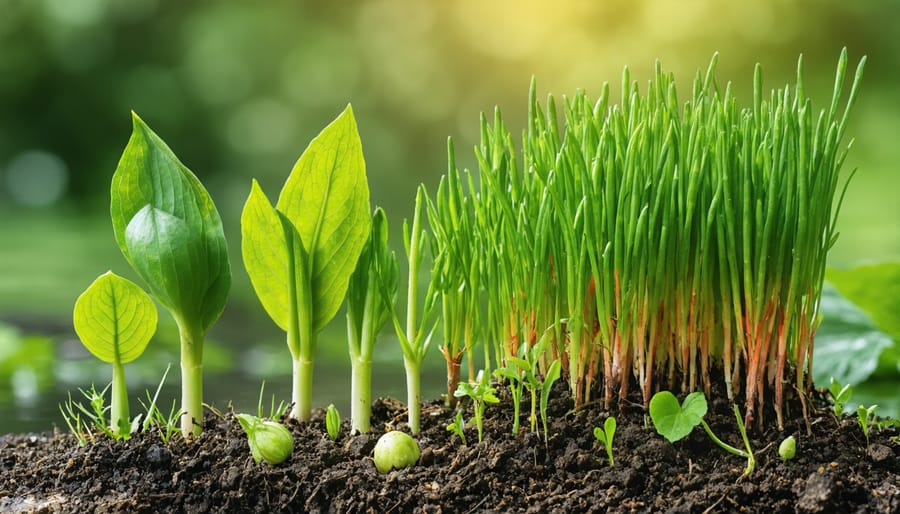
There’s something wonderfully satisfying about growing food in places you’d never expect. Your pond doesn’t have to be just a pretty feature in your backyard—it can be a productive space that feeds you while supporting a thriving ecosystem. The best part? You don’t need to transform your entire water garden overnight.
Start simple. Choose one or two edible bog plants that excite you most. Maybe it’s watercress for your sandwiches or arrowhead for its nutty tubers. Plant them in a single container at your pond’s edge and watch what happens. I promise you’ll be hooked once you taste that first harvest pulled fresh from your own water garden.
As seasons pass, you’ll discover something remarkable: these plants aren’t just giving you food. They’re clarifying your water, sheltering beneficial insects, and creating a more balanced pond environment. Your fish will appreciate the extra shade and shelter. Visiting birds might stop by more often. And you’ll have the unique pleasure of serving dinner guests vegetables they’ve likely never tasted before, all while sharing the story of your productive, beautiful pond ecosystem. That’s the long-term magic of edible water gardening—it keeps giving back in ways you never imagined.
